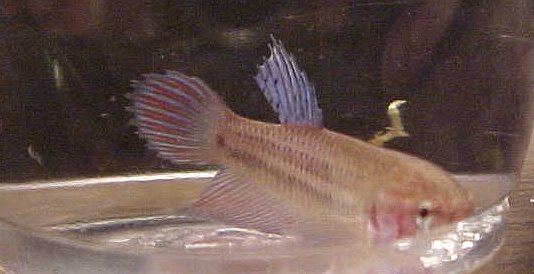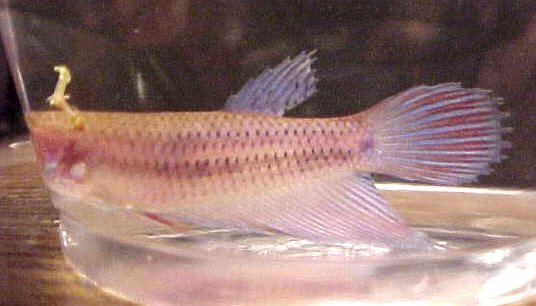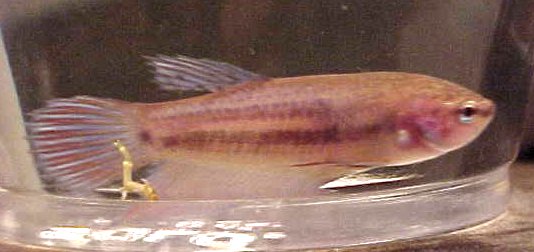|
|
|
|
Betta Breeding |
|||
I
have read everything I can find about the betta and breeding it. My
collection of these fishes has been as high as 14 at one time, each having
it's own bowl, own turn in the picture spotlight for my website, and they
are all spoiled with a variety of foods regularly. I vary between
feeding the betta pellets, live black worms, and adult brine shrimp,
whichever is available first at the time. Just before introducing
the male and female, I fed worms for 3 days, and then brine shrimp on the
day they met in the tank for the first time. I have 2 Apon. Crispus
bulbs in a 1 gallon hexagon tank with clear marbles lining the bottom of
the tank. This is my 3rd attempt at breeding. I introduced the
pair to each other on Monday night. (8/26) I skipped the
floating the female in the cup after reading a book my step daughter
loaned to me ("Bettas, A Complete
Introduction" by Walt Maurus)
|
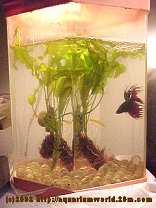
|
||
| Her stripes
changed direction the minute she saw him in the cup next to her. I
let them into the tank together at the same time. By Tuesday night
(8/27) the nest began to appear. It
took a while before the male blew his bubble nest. The female hid in
the plants while they did a bit of chasing each other. The male
chased the female, she swam away, and he continued to build. On
Wednesday (8/28) the nest grew in size quite drastically. It was
thick and covered an entire end of the tank (2 corners of the hex).
When I checked on it Wednesday night just before bed (about 4am) there
were eggs in the nest. The
female was still hiding in the plants, the male still chasing her. I
decided to try to remove her as soon as possible, but wasn't sure how
without disturbing the nest. I was patient, and Thursday (8/29)
morning she came to rest at the top near one of the plant leaves, so I was
able to reach in and scoop her out with my hand. Thursday night when
I got home from work about 9PM I checked and found baby bettas swimming
and sinking all over the tank. I wanted to post the few pictures I was so
far able to take of the new babies. In all of the places I've
searched, actual fry pictures was something I couldn't find. If
you look closely at the middle picture, you will see the 2 dark eyes at
the top, the yolk sac and then the
tail. The last picture is a good example of the yolk sac and tail.
The fry are small, and look like small white dots floating in the water.
They are already venturing from the nest, and the male is constantly
scooping them up into his mouth to return them. I notice that quite
a few are seemingly able to swim quite well already and skim the top of
the tank in rapid darting movements. I am unable to count them yet,
but it looks like quite a large number (possibly 20 or more). I
offered worms to the male tonight, but he seems too busy to entertain the
idea of food. The worms will live for a few days in the tank,
so I will watch for them to disappear. I will take pictures as much
as I can with my limited free time, and will bring them here to add to
this article later. Now that I've successfully found a breeder pair
of bettas, and neither seems stressed from the spawning ritual, I intend
to breed them again soon. If I miss a stage of development this
time, I will catch it next time. Once I have the complete cycle on
film, I will revamp this article to put it in order.
|
|

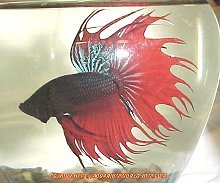
Mom & Dad
3 DAY OLD FRY
Today is Sunday (9/1) and the fry are now 3 days old. They are developing quickly, and now stay near the surface of the water. I am going to attempt a water change on the tank tonight, using a piece of air tubing that I can reach down to the bottom of the tank to draw the old water out. I plan to try to do a 30% - 40% change. I will add fresh worms for daddy betta after this is done. I have been feeding baby brine shrimp twice each day, starting yesterday. Friday at work I bought brine shrimp eggs. I discussed with Rob about how to hatch them properly, but in the end I found that following the instructions on the package was much easier. Tapping it, or siphoning off the egg shells after hatching is probably the most difficult part. The trick seems to be control of the tubing used to siphon the shells, and letting it stand long enough for them to all rise to the surface before starting. Once this is finished, either using a different tube or rinsing the current one is suggested. I choose to rinse. When I extract the baby shrimps I have found that a Bounty paper towel, rubber banded over a plastic cup, and a toothpick work well. I again siphon the shrimp, this time putting the tubing near to the bottom of the container, before sucking to start the siphon, I blow lightly a bubble or 2 into the tube to clear any egg shells that may have been caught along the way down. I siphon the water into the paper towel, swirling it a bit as it pools above the cup. When finished, I simply use a toothpick to scrape the shrimps from the paper towel and then dip the toothpick into the tank until it is clean. I have attempted to get a count of the fry, and so far it's at least 50. Below are pictures of my brine shrimp hatchery at the kitchen sink (my family loves me right now!) and new pictures of the 3 day old fry.

(Brine Hatchery)
UPDATE 10-18-02
Two of the babies from this first hatching have survived and are doing seemingly well. This is the bigger of the 2, and spends most of it's time swimming around the tank. I am going to be moving it to it's own bowl this weekend. The other baby is a bit smaller yet, so I am hoping that with nobody to share food or chase it around, it will quickly catch up in size. It's not possible yet to determine sex for sure, but this baby appears to be female, and possibly with a crowntail.
I will post more pictures when I am able to take them.
The picture on the left is her baby picture, the picture on the right is how she looks today, 7-15-03.
THE 2ND BATCH...
I learned a lot from my first experience. The first try has prepared me for the 2nd, and hopefully the outcome will be many more healthy baby bettas. I have changed tanks for breeding, finding the 1 gallon hexagon tank too small and the odd shape making it harder to care for. I also have mastered siphoning the baby brine shrimp that are needed to feed the betta fry. Feeding the fry is still the hardest part, along with water changes. The larger tank should allow me a little bit more time between changes, and the regular shape should make this easier. As promised, I have many more pictures, and hope to add more soon!
This time I started with a 5 1/2 gallon aquarium. The scanner on my desk was in need of repair, so it was removed and replaced with the breeding tank. Gravel was taken from an established tank downstairs, plants were also borrowed from my other tanks. In the center I placed a plastic plant, then floated stems of Hygro, finally planting one Hygro stem in the front corner of the tank. When setting things up, I took into account location of the tank and how best to set things up for the pictures I planned to take. Water was taken from an established tank to fill the breeding tank. In the back corner I set up a corner filter and ran it for about 20 minutes. The filter ran while I selected which of my fish to pair for this session. When choosing the male I looked through all of the bowls and chose the male with the largest bubble nest constructed in the bowl.
The female choice was much easier as I only currently have 2 females. I chose the bigger of the 2, and the only one I haven't successfully bred yet.
Knowing that diet is important in breeding, my bettas are fed black worms regularly, with pellets once/week as a treat. Once/month they are treated to live adult brine shrimp. As you can see, this female is plenty "plump" and ready for breeding.
The male was placed in the tank first, allowed to swim long enough for me to cut power to the corner filter. After each had a trip to the cup for a photo and a nice helping of worms, the female was then floated in the tank with the male.
The tank was set up the evening of 10/16/02. The filter stopped and bettas introduced to the tank at 11:30PM. At 12:15AM the female was released from her cup. 10/17/02 was a day filled with the building of the bubble nest while the male chased the female from time to time. She hid from him for most of the day and into the evening. I was fortunate enough to have been able to watch the mating ritual happen this time. I expected that after one embrace it would end, but was happy to see that they continued at least 10 times on 10/18/02 from 11:00AM until about 1:00PM. By 1:00PM the female was beginning to hide again. The first eggs went into the nest at about 11:00AM, the last around 1:00PM. When it was obvious that the male was standing guard over the nest and the female was going to continue to hide, I removed her at 2:30PM
Each embrace lasted about 1 minute or less with a few minutes between them.
The
mating rituals of the betta are unique and exciting to witness for the first
time. I almost missed capturing it on film because I was so entranced by
the beauty of it all. The chase started with the male displaying for
the female, then swimming back to his nest to blow more bubbles. The
female at some point began to return the gestures and sought out the male at the
surface. She swam around him a few times, then laid on her side as he
would wrap around her to squeeze the eggs out via her egg tube. As the
eggs were released, they floated to the bottom. The male would quickly
unwrap from around the female, all interest in her lost, as he chased after the
falling eggs. The male then gathered the eggs in his mouth and took them
up to the nest where he blew them up into the bubbles. The female simply
floated near the surface for a few moments before swimming away. Once the
eggs were safely in the nest the male would sit guard. The female then
would swim back up to him, where they would circle and end in another embrace
where more eggs were released. Above are the pictures I captured of this
wonderful dance they did before my eyes. Watching and photographing didn't
seem to disturb them at all, to which I was glad. The contrast in colors
of the 2 fish will help you to follow each fish's position.
The 2nd batch didn't make it long, this male having eaten every fry in the tank after about 48 hrs of hatching. Due to lack of time and another food source for the fry I stopped my breeding here and focused more on study. I have since started a live bearing tank, with intentions of raising the fry from both species together until the betta fry are ready to be separated. One of the many books I read suggested doing this to increase the ease in food sources and feeding the betta fry. The live bearing fry are supposed to help show them how to scavenge for food when it falls to the bottom.
I have since set up a 10 gallon tank on my desk along with a 2 gallon tank, no odd shapes this time. Ease of access was first in mind, but time is still creating a problem, so I have not started to breed again yet. I am hoping to breed the female fry that survived from the first batch and is pictured above. I will include more pictures of her below. She has a brother who has not been doing well as of recently, so I will not post his pictures in his current condition out of respect to his beauty. I will continue to search to see if I have any pictures of him captured, but I fear this one will be saved only in my memory.
I was introduced to a new food product, and am going to try it with the next batch. It's a new product by Kent Marine called ZooPlex. The description on the bottle says that it is "Concentrated Aquacultured Marine Zooplankton for Planktivorous Fish and Invertebrates. Basically it is live fish food in a bottle, small enough for the tiniest of fry to eat, and packed full of nutrition. The part that impressed me was that it was originally designed to feed marine filter feeding creatures, and has Omega-3 fatty acids and cartenoid pigments, which have been known to increase immune efficiency, growth rate, and color. When I think to what color enhancers do for marine fish, and studied to make sure that this was safe for the freshwater bettas, I am very eager to try it soon. I will post with my critique of the product once I use it myself. I won't recommend it until I've tried it first, but in dealing with Kent Marine at the store regularly, I know they make some wonderful products that can't be topped anywhere else. I will end here for now, leaving you with the last of the pictures of my surviving female fry. I took time to focus on showing her beautiful finage, so some of the pictures may be without a head due to angle difficulties.
